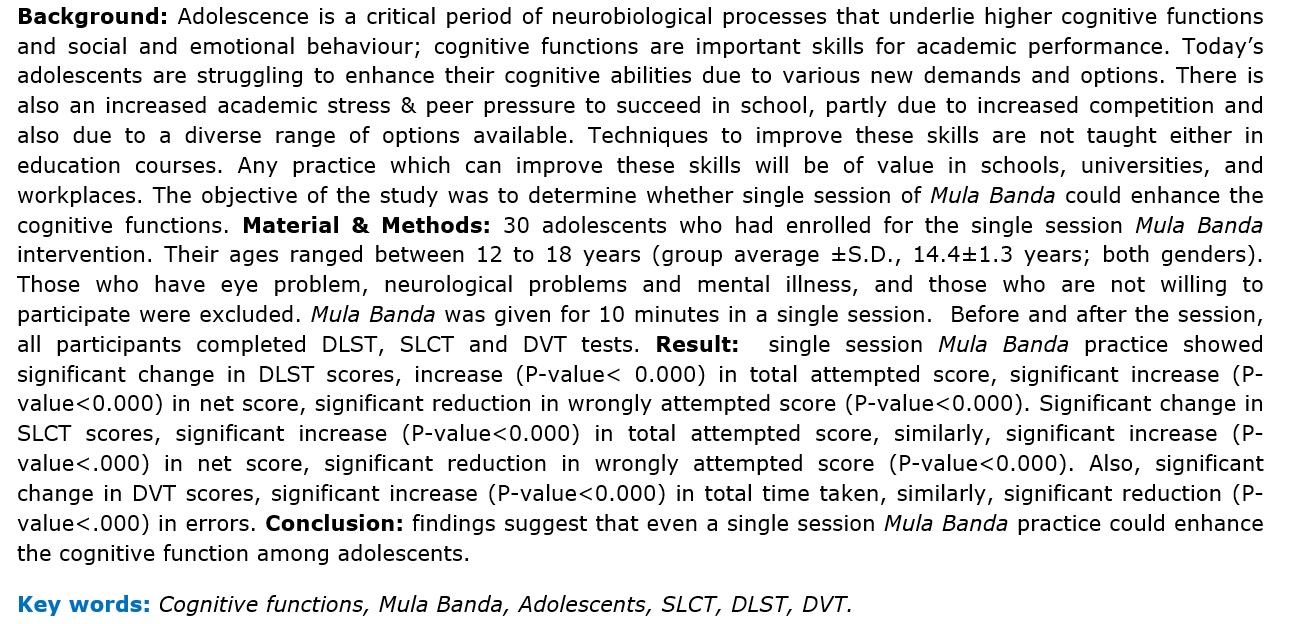Immediate effect of single session Mula Banda practice on cognitive functions among adolescents
DOI:
https://doi.org/10.21760/jaims.v6i3.1308Keywords:
Cognitive functions, Mula Banda, Adolescents, SLCT, DLST, DVT.Abstract
Background: Adolescence is a critical period of neurobiological processes that underlie higher cognitive functions and social and emotional behaviour; cognitive functions are important skills for academic performance. Today’s adolescents are struggling to enhance their cognitive abilities due to various new demands and options. There is also an increased academic stress & peer pressure to succeed in school, partly due to increased competition and also due to a diverse range of options available. Techniques to improve these skills are not taught either in education courses. Any practice which can improve these skills will be of value in schools, universities, and workplaces. The objective of the study was to determine whether single session of Mula Banda could enhance the cognitive functions. Material & Methods: 30 adolescents who had enrolled for the single session Mula Banda intervention. Their ages ranged between 12 to 18 years (group average ±S.D., 14.4±1.3 years; both genders). Those who have eye problem, neurological problems and mental illness, and those who are not willing to participate were excluded. Mula Banda was given for 10 minutes in a single session. Before and after the session, all participants completed DLST, SLCT and DVT tests. Result: single session Mula Banda practice showed significant change in DLST scores, increase (P-value< 0.000) in total attempted score, significant increase (P-value<0.000) in net score, significant reduction in wrongly attempted score (P-value<0.000). Significant change in SLCT scores, significant increase (P-value<0.000) in total attempted score, similarly, significant increase (P-value<.000) in net score, significant reduction in wrongly attempted score (P-value<0.000). Also, significant change in DVT scores, significant increase (P-value<0.000) in total time taken, similarly, significant reduction (P-value<.000) in errors. Conclusion: findings suggest that even a single session Mula Banda practice could enhance the cognitive function among adolescents.
Downloads
References
Spear LP. The adolescent brain and age-related behavioral manifestations. Neurosci Biobehav Rev. 2000; 24: 417–463.
Hagen Ingunn & Nayar Usha. Yoga for Children and Young People’s Mental Health and Well-Being. Research Review and Reflections on the Mental Health Potentials of Yoga. Frontiers in Psychiatry. 2014; 5: 35.
Kaplan GA et al. Childhood socioeconomic position and cognitive function in adulthood. Int J Epidemiol. 2001; 30: 256–263.
Khalsa SBS, Butzer B. Yoga in school settings: a research review. Ann NY Acad Sci. 2016; 1373: 45–55. doi: 10.1111/nyas.13025.
Janig W, Koltzenburg M, C A Maggi (Ed). “Pain arising from the urogenital tract,” in Nervous Control of the Urogenital System. Harwood Academic, Chur, Switzerland. 1998; 525–578,
Anita D, Barber, Majnu John, Pamela De Rosse, Michael L, Birnbaum, Todd Lencz, Anil K.Malhotra. Parasympathetic arousal-related cortical activity is associated with attention during cognitive task performance. Neuro Image. 2020; 208: 116469
Natu MV, Agarawal AK. Testing of stimulant effects of coffee on the psychomotor performance: an exercise in clinical pharmacology. Indian Journal of Pharmacology. 1997; 29(1): 11–14.
Kelland DZ, Lewis RF. The digit vigilance test: Reliability, validity, and sensitivity to diazepam. Arch Clin Neuropsychol. 1996; 11: 339–44.
Davidson RJ. Mind and Life Education Research Network (MLERN) Contemplative practices and mental training: Prospects for American education. Child Development Perspectives. 2012; 6:146–153.
Telles S, Hanumanthaiah B, Nagarathna R, Nagendra HR. Improvement in static motor performance following yogic training of school children. Percept Mot Skills. 1993; 76: 1264–1266.
Roland KP, Jakobi JM, Jones GR. Does yoga engender fitness in older adults? A critical review. J Aging Phys Act. 2011; 19: 62–79.
Lou Galantino M, Galbavy R, Quinn L. Therapeutic effects of yoga for children: a systematic review of the literature. Pediatr Phys Ther. 2008; 20: 66–80.















